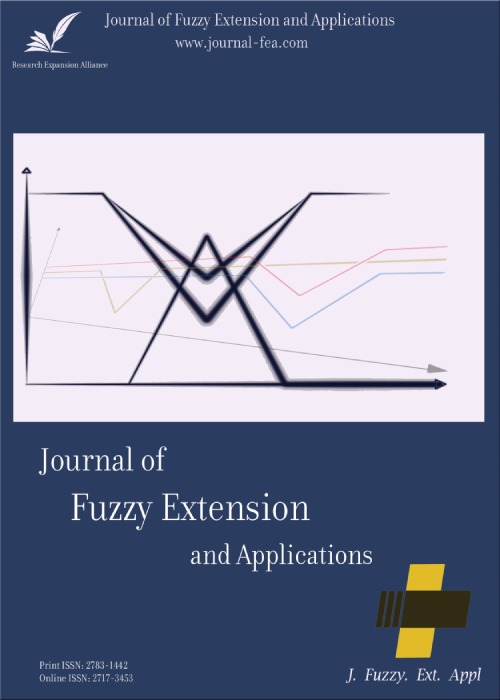فهرست مطالب
Journal of Fuzzy Extension and Applications
Volume:4 Issue: 2, Spring 2023
- تاریخ انتشار: 1402/03/11
- تعداد عناوین: 7
-
-
Pages 65-80In this paper, we define the term " η-fuzzy subgroup" and show that every fuzzy subgroup is a η-fuzzy subgroup. We define some of the algebraic properties of the concept of η-fuzzy cosets. Furthermore, we initiate the study of the η-fuzzy normal subgroup and the quotient group with respect to the η-fuzzy normal subgroup and demonstrate some of their various group theoretical properties.Keywords: fuzzy subgroup, η-fuzzy subgroup, η-fuzzy coset, η-fuzzy normal subgroup
-
Pages 81-91An effective and flexible method for encoding ambiguous data is using cubic sets. The concept of incline algebraic sub-structure is considered and is interlinked with the notation of the cubic set to define cubic subincline. The sense of cubic sub incline of algebra is established with relevant results. Additionally, the results such as homomorphic image, preimage, cartesian product and level sets of cubic sub incline are worked out in this study, and several of its associated findings were looked into.Keywords: Incline algebra, cubic sets, cubic subincline, image, preimage, Cartesian product
-
Pages 92-114In our work in this paper, we define intuitionistic fuzzy complex subgroups with respect to t-norm T and s-norm S and investigate some properties of them in detail. Next, we obtain some results about them and give some relationships between them. Later, we introduce the inverse, composition, intersection and normality of them and we prove some basic new results and present some properties of them such that the inverse and composition of two intuitionistic fuzzy complex subgroups with respect to t-norm T and s-norm S will be intuitionistic complex fuzzy subgroups with respect to t-norm T and s-norm S. Also we consider and give some characterizations of them. Finally, we discuss them under group homomorphisms and investigate some related properties such that the image and preimage of two intuitionistic fuzzy complex subgroups with respect to t-norm T and s-norm S will be intuitionistic complex fuzzy subgroups with respect to t-norm T and s-norm S.Keywords: Group theory, theory of fuzzy sets, Intuitionistic fuzzy complex groups, norms, homomorphisms, Intersection
-
Pages 115-124Picture Fuzzy Sets (PFSs) are expanded to include Intuitionistic Fuzzy Sets (IFSs), with the extra advantage of avoiding underlying limitations. PFS based models may be adequate in situations when we face opinions involving more answer of types: yes, abstain and no. In this paper, the concepts of semi-prime ideals of PFS are explained. We also discussed how to construct picture fuzzy regular and intra-regular ideals and represents certain fundamental facts.Keywords: Intuitionistic fuzzy set, Picture Fuzzy Set, Picture fuzzy ideals, Picture fuzzy semi-prime ideals, Picture fuzzy regular ideals
-
Pages 125-135This paper aims to study Pythagorean and Fermatean Fuzzy Subgroups (FFSG) in the context of -norm and -conorm functions. The paper examines the extensions of fuzzy subgroups, specifically "Pythagorean Fuzzy Subgroups (PFSG)" and "FFSG", along with their properties. In the existing literature on Pythagorean and FFSG, the standard properties for membership and non-membership functions are based on the "min" and "max" operations, respectively. However, in this work, we develop a theory that utilizes the -norm for "min" and the -conorm for "max", providing definitions of Pythagorean and FFSG with these functions, along with relevant examples. By incorporating this approach, we introduce multiple options for selecting the minimum and maximum values. Additionally, we prove several results related to Pythagorean and FFSG using the -norm and -conorm, and discuss important properties associated with them.Keywords: Fuzzy Sets, Pythagorean fuzzy subgroups, Fermatean fuzzy subgroups, T ̃-Norm, S ̃-Conorm
-
Pages 136-140The neutrosophic automorphisms of a neutrosophic groups G (I) , denoted by Aut(G (I)) is a neu-trosophic group under the usual mapping composition. It is a permutation of G (I) which is also a neutrosophic homomorphism. Moreover, suppose that X1 = X(G (I)) is the neutrosophic group of inner neutrosophic auto-morphisms of a neutrosophic group G (I) and Xn the neutrosophic group of inner neutrosophic automorphisms of Xn-1. In this paper, we show that if any neutrosophic group of the sequence G (I), X1, X2, … is the identity, then G (I) is nilpotent.Keywords: Neutrosophic automorphism, commutator subgroup, neutrosophic subgroup, minimal condition, Mapping composition, nilpotency
-
Pages 141-147The objective of this study is to incorporate topological space into the realm of n-Cylindrical Fuzzy Neutrosophic Sets (n-CyFNS), which are the most novel type of fuzzy neutrosophic sets. In this paper, we introduce n-Cylindrical Fuzzy Neutrosophic Topological Spaces (n-CyFNTS), n-Cylindrical Fuzzy Neutrosophic (n-CyFN) open sets, and n-CyFN closed sets. We also defined the n-CyFN base, n-CyFN subbase, and some related theorems here.Keywords: n-Cylindrical fuzzy neutrosophic sets, n-Cylindrical fuzzy Neutrosophic open sets, n-Cylindrical fuzzy Neutrosophic closed sets, n-cylindrical fuzzy neutrosophic base


